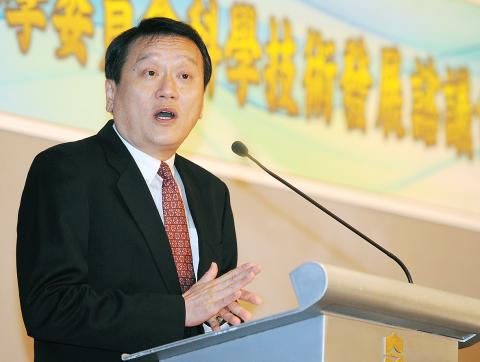The National Science Council initiated a conference yesterday in which scientific advisers to the council will discuss a growing brain drain crisis that is threatening Taiwan’s economic and technological development.
National Science Council Minister Cyrus Chu (朱敬一) said participants at the council’s two-day conference on developing science and technology will brainstorm on stopping the brain drain and also on how to better link academic research with the private sector.
Part of the problem, Chu said, is that many of the foreigners working in Taiwan are not highly skilled.

Photo: Liao Chen-huei, Taipei Times
Of the 450,000 foreign nationals who came to Taiwan to work last year, 400,000 were hired as blue-collar workers.
Most of the remaining white-collar workers were language teachers or involved in jobs that did not require technical skills or specialized knowledge, he said.
The conservative nature of Taiwanese society has also held up efforts to attract foreign professionals to work in Taiwan, he added, noting that few foreigners serve in decisionmaking positions in local companies.
At the same time, China’s aggressive efforts to recruit Taiwanese talent by offering high salaries is eroding Taiwan’s homegrown talent pool, Chu said.
On the eve of the conference, Chu raised the alarm over the brain drain, warning that Taiwan would “perish miserably” if it continued doing nothing to stop the country’s erosion of talent, according to local media reports.
The official said Taiwan has entered a “talent-gap era,” with fewer Taiwanese students going abroad for advanced studies and increasing difficulties in keeping talent at home or attracting top professionals from abroad, the Chinese-language United Daily News reported.
The Industrial Technology Research Institute, Taiwan’s top technology research agency, has already lost several senior executives to similar research organizations in China because it was unable to match China’s lucrative salary and benefits offers, Chu said.
To stop the drain, the minister said Taiwan should define “talent” and “workers” separately, and he suggested that caps on senior officials’ salaries at national research institutes should be lifted.
The government would use the conclusions from the conference as a reference when devising science and technology development strategies, the council said.

SHIPS, TRAINS AND AUTOMOBILES: The ministry has announced changes to varied transportation industries taking effect soon, with a number of effects for passengers Beginning next month, the post office is canceling signature upon delivery and written inquiry services for international registered small packets in accordance with the new policy of the Universal Postal Union, the Ministry of Transportation and Communications said yesterday. The new policy does not apply to packets that are to be delivered to China, the ministry said. Senders of international registered small packets would receive a NT$10 rebate on postage if the packets are sent from Jan. 1 to March 31, it added. The ministry said that three other policies are also scheduled to take effect next month. International cruise ship operators

NUMBERS IMBALANCE: More than 4 million Taiwanese have visited China this year, while only about half a million Chinese have visited here Beijing has yet to respond to Taiwan’s requests for negotiation over matters related to the recovery of cross-strait tourism, the Tourism Administration said yesterday. Taiwan’s tourism authority issued the statement after Chinese-language daily the China Times reported yesterday that the government’s policy of banning group tours to China does not stop Taiwanese from visiting the country. As of October, more than 4.2 million had traveled to China this year, exceeding last year. Beijing estimated the number of Taiwanese tourists in China could reach 4.5 million this year. By contrast, only 500,000 Chinese tourists are expected in Taiwan, the report said. The report

Temperatures are forecast to drop steadily as a continental cold air mass moves across Taiwan, with some areas also likely to see heavy rainfall, the Central Weather Administration (CWA) said. From today through early tomorrow, a cold air mass would keep temperatures low across central and northern Taiwan, and the eastern half of Taiwan proper, with isolated brief showers forecast along Keelung’s north coast, Taipei and New Taipei City’s mountainous areas and eastern Taiwan, it said. Lows of 11°C to 15°C are forecast in central and northern Taiwan, Yilan County, and the outlying Kinmen and Lienchiang (Matsu) counties, and 14°C to 17°C

STEERING FAILURE: The first boat of its class is experiencing teething issues as it readies for acceptance by the navy, according to a recent story about rudder failure The Hai Kun (海鯤), the nation’s first locally built submarine, allegedly suffered a total failure of stern hydraulic systems during the second round of sea acceptance trials on June 26, and sailors were forced to manually operate the X-rudder to turn the submarine and return to port, news Web site Mirror Daily reported yesterday. The report said that tugboats following the Hai Kun assisted the submarine in avoiding collisions with other ships due to the X-rudder malfunctioning. At the time of the report, the submarine had completed its trials and was scheduled to begin diving and surfacing tests in shallow areas. The X-rudder,